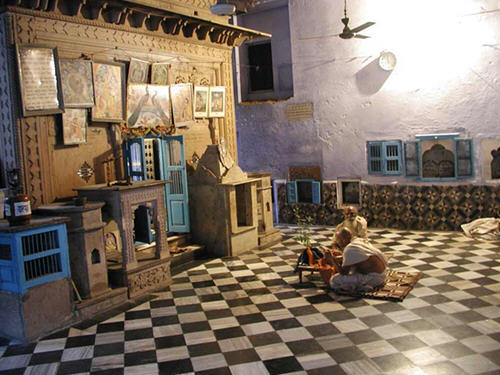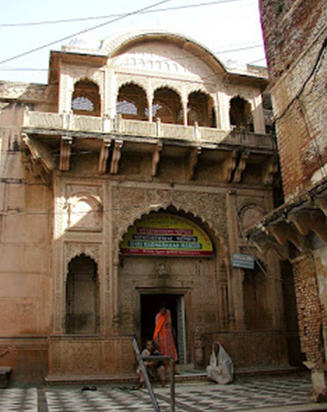
Sri Sri Radha Raman Temple:
Constructed at the request of Gopala Bhatta Goswami in the sixteenth century, Radha Raman temple is one of the most exquisitely crafted and revered temples of Vrindavan ”Radha Ramana” means “one who gives pleasure to Radha”, and Radha Ramana is one of the few original deities still left in Vrindavan. The cooking fire in the temple kitchen have been burning continuously since the Deity was installed over 460 years ago and the cooking still follows cookbooks from that time.
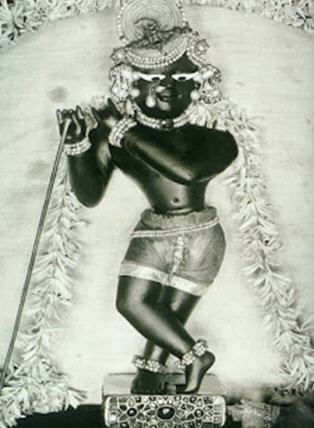
When Lord Caitanya Mahaprabhu was touring South India, He spent the four months during the rainy season called Caturmasya in Shri Rangam at the house of Vyenkata Bhatta, the chief priest of the Ranganatha Temple. His son, Shri Gopal Bhatta, was then able to serve the Lord to his heart’s content. Being pleased by his devotion, Shri Caitanya gave him initiation and ordered him to go to Vrindavana after the disappearance of his parents. There he should remain with Rupa and Sanatana doing bhajana and writing books. At an age of thirty, after the death of his parents, Gopala Bhatta, left for Vrindavana. When Lord Caitanya heard that Gopala Bhatta Goswami had arrived in Vrindavana and had met Shri Rupa and Sanatana Goswami, He was very pleased. At that time Mahaprabhu had already visited Vrindavana. Although Rupa and Sanatana had gone to visit him in Puri, Gopala Bhatta never received any invitation to go. Understanding his disappointment, Shri Caitanya sent His personal asana and cloth to him through Rupa and Sanatana, which can still be seen on special festivals in Radharamana Temple.
Later when Gopala Bhatta heard of the disappearance of Mahaprabhu, he felt intense separation from the Lord, having associated with him only in his childhood.
One night Lord Caitanya appeared in a dream and told him, “If you want my darshana, make a pilgrimage to Nepal.” In Nepal, Gopala Bhatta visited the river Gandaki. After taking bath, he filled his water pot and was surprised to see that some Shalagrama-shilas had entered it. Emptying his pot, he filled it again, only to find the shilas had re-entered his water pot. Again he emptied his pot, and when he filled it for a third time he found that now twelve Shalagrama-shilas were there. Thinking this must be the mercy of the Lord, he decided to bring those shilas with him to Vrindavana. One day after returning to Vrindavana, a wealthy devotee approached Gopala Bhatta Goswami with dresses and ornaments for his Deity. Gopala Bhatta told him that as he was only worshiping a shalagrama-shila, it would be better to give to someone else who was worshiping a Deity and could use them. It happened to be Narasimha-caturdasi and thinking deeply on this incident Gopala Bhatta remembered how Lord Narasimha deva had manifested from a stone pillar. He then began to pray to the Lord, “O Lord, you are very merciful and fulfill the desires of your devotees. I wish to serve you in your full form.” In ecstasy he read the chapters of Shrimad Bhagvatam about Lord Narasimha deva’s pastimes, and then took rest. In the morning when he awoke, he found that one of the twelve Shalagramas, the Damodara-shila, had manifested as Shri Radharamana.
He immediately called Rupa and Sanatana and all the other devotees. They were all astounded by the beauty of Shri Radharamanaji. They remarked that from the feet to the waist He had the form of Shri Madana-Mohanaji, His chest was like that of Shri Gopinathaji and He had the moonlike face of Shri Govindadeva. Then with the blessing of all the Vaishnavas, he began the worship of Shri Radharamanaji.

Sri Sri Radha Raman:
ananga-manjari yasit sadya gopala-bhattakah
bhatta-gosvaminam kecit ahuh sri-guna-manjari
She who was formerly Ananga Manjari who has appeared to enrich Mahaprabhu’s pastimes as Srila Gopal Bhatta Goswami. Some say that Gopal Bhatta is actually Guna Manjari. (Gaura-ganoddesa-dipika 184)
Srila Gopal Bhatta Goswami appeared in 1500 AD (though, according to some authorities, he was born in 1503) as the son of Venkata Bhatta in the town of Srirangam in South India. Their residence was in a village not far from Srirangam called Belagundi.
According to Narahari sarkar in the Bhakti-ratnakara, Srila Gopal Bhatta Goswami was given a vision in a dream by Mahaprabhu in which he was fortunate enough to witness all the Lord’s Nabadwip pastimes. An eternal associate of Krishna, he appeared in a faraway place in order to participate in Lord Gauranga’s pastimes. Even so, he was able to know long before he even saw him that the Lord had appeared and taken sannyas. Gopal Bhatta did not particularly like the Lord’s appearance as a sannyasi. He was distressed and crying alone when the Lord appeared to him and gave him the dream vision of his Nabadwip lila. In this vision, the Lord was overwhelmed by ecstatic love, embraced him and drenched him in his tears.
Having said this to Gopal, the Lord embraced him and drenched him in his tears. He then told him to keep all these experiences secret, and Gopal felt great joy in his mind. (Bhakti-ratnakara 1.123-4)
Through the power of Sri Krishna Chaitanya Mahaprabhu’s merciful association, Venkata Bhatta, his brother Prabodhananda Saraswati, his son Gopal Bhatta Goswami, and all the other members of his family, were inspired to be engaged in the exclusive devotional service of Radha and Krishna. Srila Gopal Bhatta Goswami took initiation from his uncle, Tridandi Yati Srimat Prabodhananda Saraswati. Proof of this is found in the Hari-bhakti-vilasa:
bhakter vilasams cinute prabodha-
nandasya sisyo bhagavat-priyasya
gopala-bhatto raghunatha-dasam
santosayan rupa-sanatanau ca
Gopal Bhatta, the disciple of Prabodhananda who is dear to the Lord, has collected these devotional activities to satisfy Raghunath Das, Rupa and Sanatan Goswamis. (Hbv 1.2)
Gopal’s parents were very fortunate, for they surrendered themselves, life and soul, to the feet of Lord Chaitanya. They ordered their son to go to Vrindavan before they left this world, absorbed in meditating on the Lord. Gopal travelled directly to Vrindavan where he met with Rupa and Sanatan. (Bhakti-ratnakara 1.163-5)
When Gopal arrived in Vrindavan, Rupa and Sanatan wrote to Mahaprabhu to tell him. The Lord was overjoyed and immediately wrote back telling them to affectionately take care of him as though he were their own younger brother. Srila Sanatan Goswami compiled the Hari-bhakti-vilasa and published it in Srila Gopal Bhatta Goswami’s name. Rupa Goswami considered Gopal to be as dear to him as his own life and engaged him in the deity worship of Radha Raman.
Sri Gopal Bhatt Goswami became one of the Six Goswamis, but he always kept an attitude of meekness and humility. Thus, when Krishnadas Kaviraj approached him for permission to write the Chaitanya Charitamrita, he granted it, but under the condition that he not write about him. Krishnadas Kaviraj Goswami could not go against the order of Gopal Bhatta and thus did nothing more than mention his name. Sri Jiva Goswami writes in the introduction to the Sat-sandarbha that he wrote it on the basis of an earlier text by Gopal Bhatta. Srila Gopal Bhatta Goswami also wrote a book called the Sat-kriya-sara-dipika (“Light on the essential sacraments for the Vaishnavas”). Thus his contribution to Gaudiya Vaishnava literature was in editing the Hari-bhakti-vilasa, preparing the notes for Jiva’s Sat-sandarbha and in compiling the Sat-kriya-sara-dipika. He also gave great joy to the community of devotees by writing a commentary on Bilvamangala’s Krishna-karnamrta.
Amongst his disciples were Srinivas Acharya and Sri Gopinath Das Goswami.
Srimad Gopala Bhatta Goswami lived within this world for 75 years. In the Christian year of 1578 on the sixth day of the dark moon, Sri Gopala Bhatta Goswami left this world behind and entered into the eternal pastimes of the Lord.
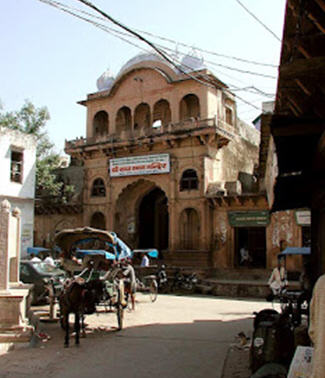
Timings:
Summer – Mangala Arati 4:00am
Darshan – 08:00am -12:30pm
(look out for the green light when you first enter the Gosai compound, up on the left)
(If it is red then darshan is over)
Evening Darshan: – 6pm – 8pm (18:00 – 20:00 hrs)
Winter – Mangala Arati 05:30am
Darshan – 08:00am – 12:30pm
Evening – 6pm – 8pm (18:00 – 20:00 hrs)
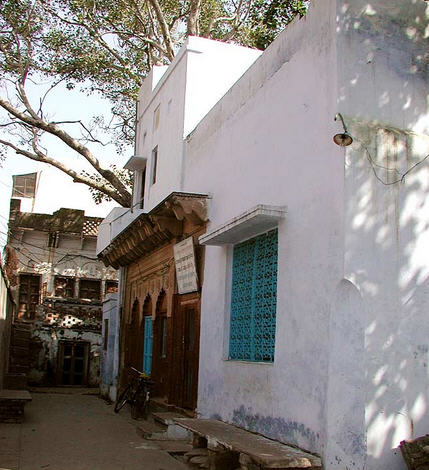
Gopal Bhatta Goswami’s samadhi is to the left after you enter the first gate from the street into the temple compound. Gopal Bhatta Goswami was the son of Vyenkatta Bhatta, a brahmana priest of Srirangam temple in Tamil Nadu. His uncle Prabhodananda Sarasvati also became his spiritual master. In 1511 Sri Caitanya Mahaprabhu visited Srirangam and danced in ecstasy before Lord Ranganath.

The appearance place of Sri Radharaman Deity is next to the temple besides Gopal Bhatta’s samadhi.

